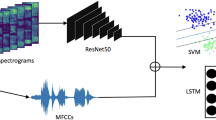Abstract
All humans have the intelligence for emotions through emotional behaviour by social skills and by interacting with and imitating humans. Not only that, we also enhance and upgrade our skills for analysis of different emotions through learning with our experience in our surroundings. Now, what if the machine is capable of learning through its artificial intelligent skills? The ongoing exploration is being done using the deep learning model concept. This technique is being used to enhance the learning capacity of the machine which is most important in human emotion recognition because one emotion can be derived towards another type of emotion which is difficult to analyse. This theme has inclined us to explore this problem. The proposed method has been designed to categorize the human emotions through four different deep learning models, which are convolutional neural network (CNN), recurrent neural network (RNN), long short-term memory (LSTM) and gated recurrent unit (GRU). For training these models, well-known physical and perceptual features have been fitted. The system has been tested on the benchmark data of Ryerson Audio-Visual Dataset for Emotional Speech and Song (RAVDESS). Furthermore, the mentioned deep learning model has been compared based on testing the above dataset in terms of the vanishing gradient problem. In addition, an upgraded model of LSTM has been proposed to get better accuracy and it is being tested with the existing model of LSTM.
Access this chapter
Tax calculation will be finalised at checkout
Purchases are for personal use only
Similar content being viewed by others
References
Han, K., Yu, D., Tashev, I.: Speech emotion recognition using deep neural network and extreme learning machine. In: Fifteenth Annual Conference of the International Speech Communication Association (2014)
Kim, Y., Lee, H., Provost, E.M.: Deep learning for robust feature generation in audiovisual emotion recognition. In: 2013 IEEE International Conference on Acoustics, Speech and Signal Processing. IEEE (2013)
Zheng, W.Q., Yu, J.S., Zou, Y.X.: An experimental study of speech emotion recognition based on deep convolutional neural networks. In: 2015 International Conference on Affective Computing and Intelligent Interaction (ACII). IEEE (2015)
Satt, A., Rozenberg, S., Hoory, R.:. Efficient emotion recognition from speech using deep learning on spectrograms. In: INTERSPEECH (2017)
Lee, J., Tashev, I.: High-level feature representation using recurrent neural network for speech emotion recognition. In: Sixteenth Annual Conference of the International Speech Communication Association (2015)
Mao, Q., et al.: Learning salient features for speech emotion recognition using convolutional neural networks. IEEE transactions on multimedia 16(8), 2203–2213 (2014)
Mirsamadi, S., Barsoum, E., Zhang, C.: Automatic speech emotion recognition using recurrent neural networks with local attention. In: 2017 IEEE International Conference on Acoustics, Speech and Signal Processing (ICASSP). IEEE (2017)
Trigeorgis, G., et al.: Adieu features? end-to-end speech emotion recognition using a deep convolutional recurrent network. In 2016 IEEE International Conference on Acoustics, Speech and Signal Processing (ICASSP). IEEE (2016)
Kahou, S.E., et al.: Combining modality specific deep neural networks for emotion recognition in video. In: Proceedings of the 15th ACM on International Conference on Multimodal Interaction. ACM (2013)
Aldeneh, Z., Provost, E.M.: Using regional saliency for speech emotion recognition. In: 2017 IEEE International Conference on Acoustics, Speech and Signal Processing (ICASSP). IEEE (2017)
Chernykh, V., Prikhodko, P.: Emotion recognition from speech with recurrent neural networks. arXiv preprint arXiv:1701.08071 (2017)
The Ryerson Audio Visual Database of Emotional Speech and Song (RAVDESS). https://zenodo.org/record/1188976#.XU739B0zbIV
Acknowledgements
This chapter does not contain any studies with human participants or animals performed by any of the authors.
Author information
Authors and Affiliations
Editor information
Editors and Affiliations
Rights and permissions
Copyright information
© 2020 Springer Nature Singapore Pte Ltd.
About this paper
Cite this paper
Bhowmik, S., Chatterjee, A., Biswas, S., Farhin, R., Yasmin, G. (2020). Speech-Based Emotion Classification for Human by Introducing Upgraded Long Short-Term Memory (ULSTM). In: Das, A., Nayak, J., Naik, B., Dutta, S., Pelusi, D. (eds) Computational Intelligence in Pattern Recognition. Advances in Intelligent Systems and Computing, vol 1120. Springer, Singapore. https://doi.org/10.1007/978-981-15-2449-3_8
Download citation
DOI: https://doi.org/10.1007/978-981-15-2449-3_8
Published:
Publisher Name: Springer, Singapore
Print ISBN: 978-981-15-2448-6
Online ISBN: 978-981-15-2449-3
eBook Packages: Intelligent Technologies and RoboticsIntelligent Technologies and Robotics (R0)




